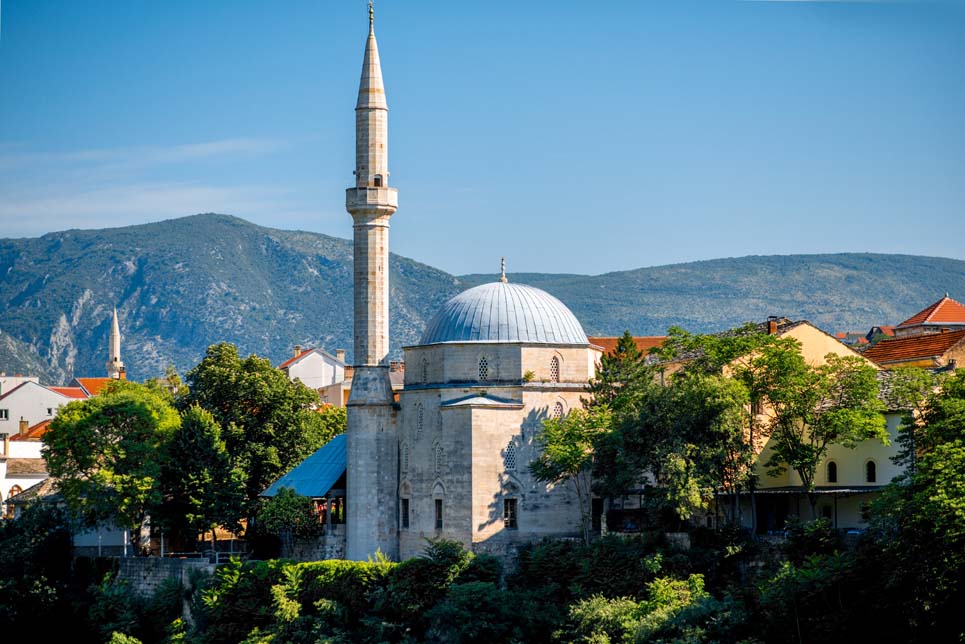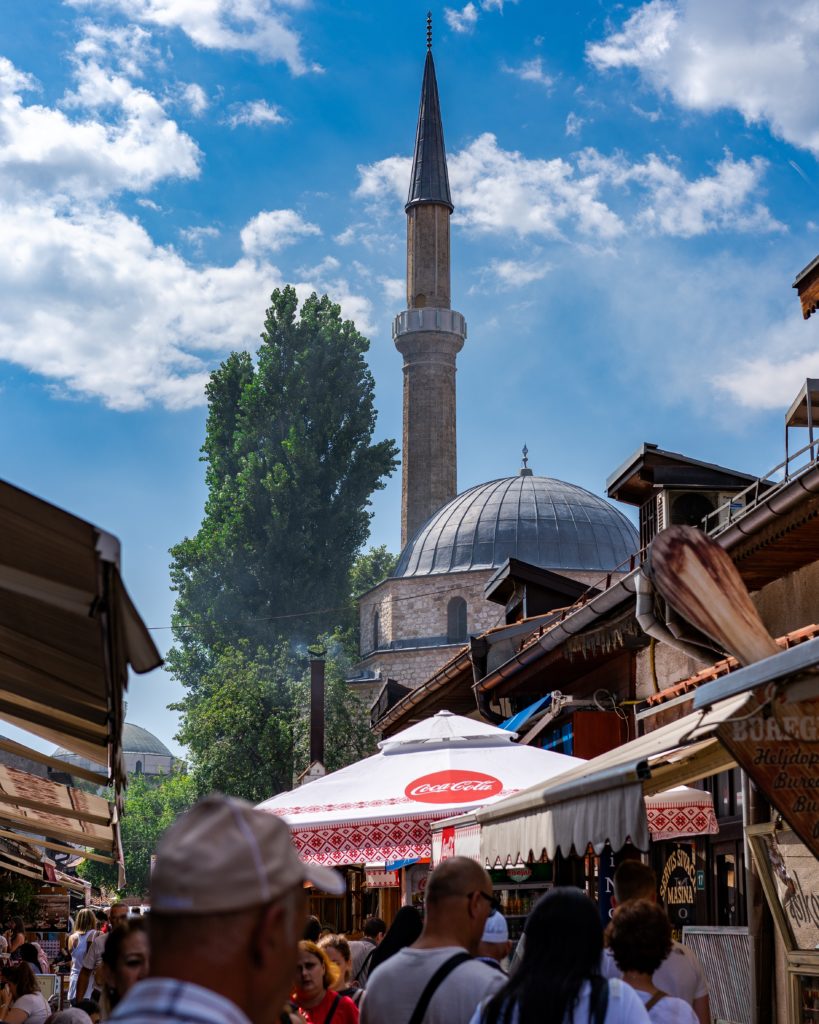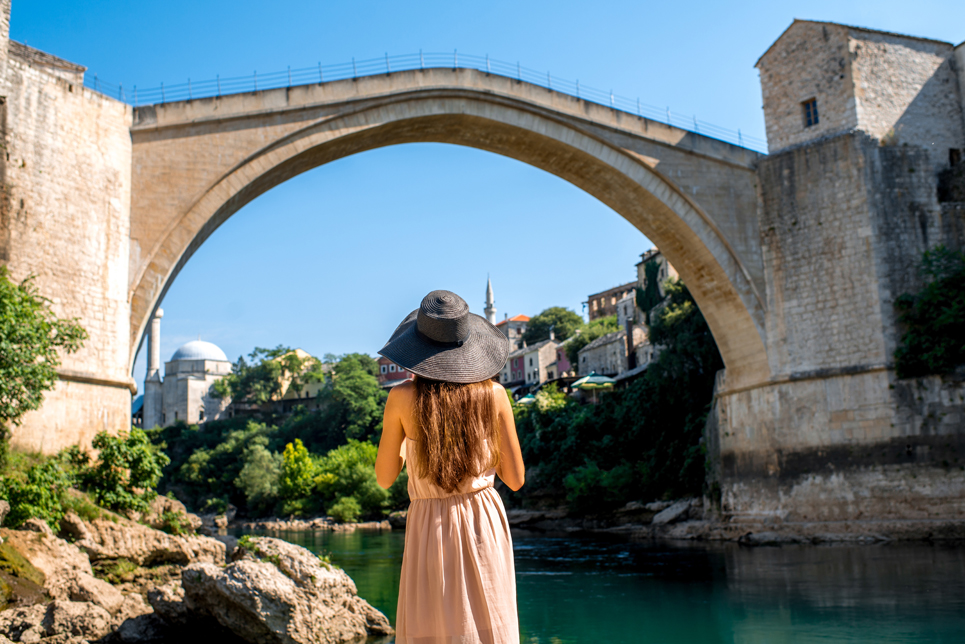A love letter to Bosnia and Herzegovina, known as the heart-shaped land. Read on for the top things to do when spending 48 hours in Sarajevo and Mostar!
The first time I ever visited Bosnia and Herzegovina, I arrived at the border after midnight on a crowded overnight bus.
I was the only English speaker on the entire bus and my Bosnian language skills extended to ‘hello’, ‘please’ and ‘thank you’, so I jumbled all three phrases together as I handed over my passport and… waited.
After what felt like a lifetime, or at least five Sufjan Stevens songs later, the bus driver yelled out ‘Australia’ and waved my passport in the air with a smile. A few bemused glances turned in my direction.
Yep, I had found myself a very long way from home.
As we crossed the border, I had no idea just how deeply Bosnia and Herzegovina would resonate with me on that first week I spent there: visiting its historic buildings, eating meals with locals and learning about the history of their home country.

Over the years, I felt compelled to return with the same old backpack, to recreate the magic of my first impressions of Bosnia and Herzegovina.
But in 2018, working as a Trip Leader for Topdeck, I had the incredible opportunity to lead the European Pioneer trip through Mostar and Sarajevo in summer and share my favourite parts of the city with other fresh-eyed travellers.
History of the heart-shaped country
As we crossed the familiar border, this time in the Topdeck coach (and not at midnight), I played Bosnian music from a Spotify playlist and spoke about the history of the heart-shaped country. This name has a double meaning: the nation is shaped like a heart on the map of Europe and it also refers to the warm-hearted, welcoming people you’ll meet here.
It’s hard to imagine that life here was so drastically different just over two decades ago, during the Bosnian War (1992-1995).
During this time, the capital city of Sarajevo was under siege and the war-torn main street became so perilous, it was renamed ‘Sniper Alley’. Families lived through freezing winters, with dwindling supplies and the daily fear of snipers and shelling attacks.
Words can do no justice to describe the horror of this time, which became the longest siege of a capital city in modern history.
I recommend reading Zlata’s Diary, by Zlata Filipovic, who was eleven years old when the war began. In 1993, she was able to publish her diary and escape from Sarajevo to Paris with her family.
Today, the city is peaceful, but bullet holes and shelling scars are reminders of this not-so-distant past.
What to expect in Sarajevo

Sarajevo is famous for its historical landmarks, annual film festival (held in August) and its East-meets-West cuisine and coffee.
As the sun sets, the city comes alive with bars and hangouts like Boardroom in Old Town or the Sarajevo Brewery.
The best part? Sarajevo’s city centre is very walkable. We checked out the sights below on our walking tour of Sarajevo:
- Sarajevo Rose: Holes in the footpath from mortar explosions have been filled with red resin to resemble roses (we visited the rose in front of Sacred Heart Cathedral)
- Bascarsija: Ottoman-influenced 15th-century bazaar and cultural heart of the city, where you can shop and eat to your heart’s content
- Sebilj Fountain: Fill up your water bottle here – legend says you will return to Sarajevo if you drink from the fountain!
- Sevdah Art House: A quiet café to try Bosnian coffee and pastries while learning about the history of traditional Sevdah music
- Gazi Husrev-beg Mosque: Largest mosque in Bosnia and Herzegovina (dating back to the 16th century)
- Latin Bridge: Franz Ferdinand, heir to the Austro-Hungarian throne, and his wife were assassinated here in 1914, leading to WW1. Next to the bridge, you’ll find a museum dedicated to this event
- Vijećnica (City Hall): Also housing the National Library, the Town Hall was destroyed during the Siege of Sarajevo. While most of the books could not be saved, the building was reopened in 2014. Don’t forget to look up at the beautiful stained-glass ceiling!
A visit to Mostar
Just a couple of hours drive from Sarajevo, Mostar’s fascinating Old Town is nestled in a deep valley on the banks of the Neretva River. Here, you’ll scope out historic Turkish-style houses as you walk through cobblestone streets to the UNESCO-listed Stari Most (Old Bridge), reconstructed after the Bosnian War.
Over the years, the rebuilt 16th-century bridge has become well known for its famous jump. Yep, local divers and their freshly trained novices take turns to make the 24m plunge into icy water. As for me, I was pretty happy to watch the bridge diving from a distance!

When we visited Mostar on the European Pioneer trip, we saw the bridge divers in action before grabbing some lunch together at a restaurant overlooking the river. We made sure to order all of the Bosnian specialties:
- Ćevapi: small sausages served on fresh pita with onion
- Burek: pastry with meat or cheese filling
- Tufahija: stewed apple stuffed with walnuts
If you’re a coffee lover, ask a local to help you pour a strong Bosnian coffee 😉 Most people find it very bitter, so you can try it with sugar cubes or a Bosnian sweet pastry.
The incredible food is just one of the reasons you’ll fall in love with this thriving heart-shaped nation.
Are you inspired to explore Bosnia and Herzegovina? You can visit Sarajevo and Mostar on many Topdeck trips including European Pioneer (37 Days) and Balkan Trail (8 Days).
